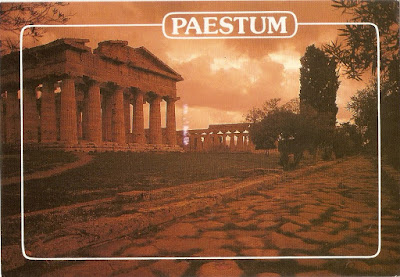Paestum is the classical Roman name of a major Graeco-Roman city in the Campania region of Italy. It is located in the north of Cilento, near the coast about 85 km SE of Naples in the province of Salerno, and belongs to the commune of Capaccio, officially also named Capaccio-Paestum.
Founded around the end of the 7th century BC by colonists from the Greek city of Sybaris, and originally known as Poseidonia. Outside of archaeological evidence very little is known about Paestum during its first centuries. Archaeological evidence indicates that the city was expanding with the building of roads, temples and other features of a growing city. Coinage, architecture and molded votive figurines all attest to close relations maintained with Metaponto in the sixth and fifth centuries. It is not until the end of the fifth century BC that the city is mentioned, when according to Strabo the city was conquered by the Lucani. From the archaeological evidence it appears that the two cultures, Greek and Oscan, were able to thrive alongside one another. What is known is it later became the Roman city of Paestum in 273 BC after the Graeco-Italian Poseidonians sided with the loser, Pyrrhus, in war against Rome during the first quarter of the third century BC.
During the invasion of Italy by Hannibal the city remained faithful to Rome and afterwards was granted special favours such as the minting of its coinage. The city continued to prosper during the Roman imperial period, but started to go into decline between the 4th and 7th centuries. It was abandoned during the Middle Ages and its ruins only came to notice again in the 18th century, following the rediscovery of the Roman cities of Pompeii and Herculaneum. The decline and desertion were probably due to changes in local land drainage patterns, leading to swampy malarial conditions (this is difficult to picture, with the present aridity; the site is now left to lizards and a few tourists).
On September 9, 1943, Paestum was the location of the landing beaches of the U.S. 36th Infantry Division during the Allied invasion of Italy. German forces resisted the landings from the outset, causing heavy fighting within and around the town. Combat persisted around the town for nine days before the Germans withdrew to the north.


No comments:
Post a Comment